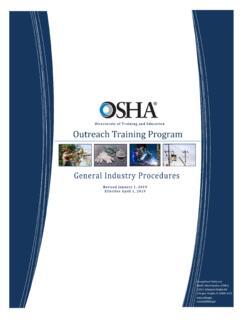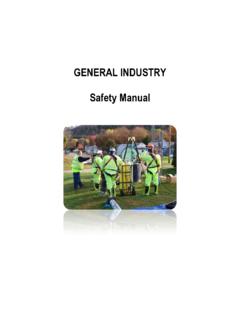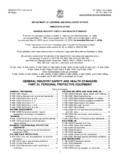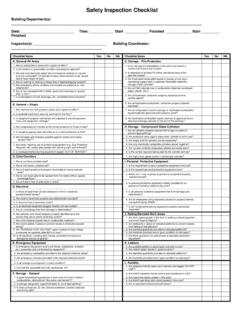Transcription of ECS Electrical Safety Unit Assessment Guide
1 ECS Electrical Safety unit Assessment Guide The ECS Electrical Safety unit Assessment has been developed to provide a basic Electrical industry Safety qualification to support the application of an ECS Related Discipline or other defined ECS cards. The Assessment covers the essential Safety aspects of carrying out electrotechnical work in a specialised occupation allied to an Electrical installation that has already been installed by an ECS gold card holder (typically an Installation Electrician holding a Registered Electrician status). The criteria of the Assessment is based around safe working of electrotechnical allied trades carrying out associated installation works with an emphasis on when to make sure Electrical installation work is carried out by suitably qualified ECS cardholder. To apply for an ECS related discipline card the applicant must hold a valid ECS Health, Safety and Environmental (HS&E) Assessment plus the ECS Electrical Safety unit . The ECS HS&E Assessment must be booked and taken separately from the ECS Electrical Safety unit Assessment .
2 For full details of all ECS card requirements please see Delegates for the ECS Electrical Safety unit Assessment are assumed to have a level of knowledge and competency in basic Electrical theory and principles. It is strongly advised that all delegate undertake suitable training prior to undertaking the ECS Electrical Safety unit Assessment . The ECS Electrical Safety unit Assessment is not suitable, on its own, for people entering the Electrotechnical sector or who are looking to train as an electrician and is not recognised as an Electrical theory qualification. Assessment Availability The ECS Electrical Safety unit Assessment is available from the JIB, ECA, Unite the Union and JIB Registered and Preferred Training Providers. In addition, some employers may be able to provide the assessments to their directly employed staff. About the Assessment Each Assessment consists of 30 questions across a range of topics relevant to Electrical Safety to be completed in 30 minutes. Each question will require the correct answer to be selected from a choice of four possible answers given.
3 The pass mark is 24 (80%) correctly answered questions. The topics and Assessment criteria are set out below with sample questions for reference. Delegates are strongly encouraged to study these and undertake suitable training before undertaking the Assessment . At the Assessment The delegate must provide the following when taking the Assessment : Photographic identification such as a current passport, photo driving license or their valid ECS card. National Insurance Number. A valid personal email address (for the Assessment result confirmation to be sent to the delegate). The invigilator will take a photograph of the delegate as evidence that they took the Assessment and monitor the delegate during the Assessment . The delegate will be informed of their result at the end of the Assessment and will also be able to see the correct answers for the Assessment they have taken. For full details of the Electrotechnical Certification Scheme (ECS) and the qualification requirements to ECS card applications please visit ECS Electrical Safety unit - Delegate Guide 08-2020 Page 1 of 6.
4 Criteria for ECS Electrical Safety unit Assessment Assessment area Number of Criteria for Assessment - general questions 1. The dangers of 4 State the effects on the body from Electrical contact. electricity State the emergency procedures and immediate first aid in the event of electric shock. State the basic elements of Electrical circuits in terms of current, voltage and resistance. Identify Electrical hazard warning signs and the differing risks of various voltage levels. Identify sources of information and guidance in respect to Electrical Safety . 2. Electrical 2 State the relevant regulations and legislation to working with Electrical equipment: regulations and The Electricity at Work. legislation. Regulations BS7671 regulations (as amended) including guidance notes. 3. Safe working 3 State the importance of Isolation of Electrical equipment. practices on Electrical Identify the basic test equipment tools for safe isolation and testing and Electrical installations. installations.
5 State the procedures for safe Isolation of Electrical equipment. State the procedures for inspection and testing of Electrical equipment post installation and maintenance work. 4. Cabling and 5 State cable types and insulation colour codes for low and extra low voltage cables. earthing systems. State the source and voltages of Single and 3 phase supplies. State basic earthing system configuration and identify fault paths and types of protection devices. 5. Limits and 2 Identify competency levels, roles and responsibilities and extent of work to be boundaries when carried out on Electrical installation for a delated electrotechnical discipline. working on Electrical installations. List the voltage range of low and extra low voltage supply systems. 6. Basic Electrical 4 Identify supply and distribution equipment. equipment types. Identify basic common types of Electrical accessories. Identify common Electrical equipment and their configurations (such as transformers, inverters, batteries).
6 ECS Electrical Safety unit - Delegate Guide 08-2020 Page 2 of 6. 7. Risk assessments, 4 Identify required documentation, procedures and safeguards, legal requirements. method statements, safe systems of work Identify roles and responsibilities. Duties for the person working on the and permits to work. electrotechnical installation and sources of guidance. 8. Basic 6 State the procedures for safe of Isolation of Electrical equipment. requirements of Testing Electrical Identify visually inspection requirements before energising installed or maintained Installations. Electrical equipment. State the testing procedure to be undertaken before energising installed or maintained Electrical equipment. ECS Electrical Safety unit - Delegate Guide 08-2020 Page 3 of 6. ECS Electrical Safety unit Assessment Example questions to assist with the Assessment of Underpinning Knowledge The example questions in this section are intended to help delegates prepare for the ECS Electrical Safety unit underpinning knowledge Assessment .
7 To answer these questions you may need to do some research. They are intended to help you gain the level of knowledge you will need for the Assessment test. It is recommended that you use these questions to prepare for the Assessment alongside a supported training programme from a training provider, either classroom based or online, before you take the Assessment . The answers are not provided, and delegates should carry out their own research and discuss their suggested answers with their training provider, colleagues and/or employers as required. 1. What is the relationship between Voltage (V), Current (C) and Resistance (R)? a. V = I + R. b. V = I x R. c. V = I R. d. V = I / R. 2. What is the danger associated with Electrical installations powered through a UPS protected Supply? a. The possibilities of a high voltage being present b. The UPS may continue to supply mains if the supply power is isolated c. The UPS is not earthed when turned off d. The UPS output has exposed terminals 3.
8 Which document specifically details the Safety requirements for Electrical working? a. Electricity at Work Regulations 1989. b. The Health and Safety at Work Act 1974. c. The IET Wiring Regulations (BS7671). d. BS-EN 50173 Cabling Standards 4. The normal procedure for working on Electrical equipment should be which one of the following? a. Dead working b. Wearing insulated gloves c. Using insulated tools d. Live working ECS Electrical Safety unit - Delegate Guide 08-2020 Page 4 of 6. 5. If a fuse blows again after being replaced the correct procedure is a. Call the electricity supply company to upgrade the supply b. Replace the fuse with increasingly larger ratings until it doesn't blow again c. Isolate the supply and replace the circuit cable d. Isolate the circuit or device, then trace and rectify the fault 6. Extraneous-conductive-parts require protective equipotential bonding to ensure that? a. The exposed parts are isolated from earth b. No dangerous potential difference can occur c.
9 Utility pipes can be used as earth electrodes d. No connection with a cpc is required 7. The nominal single-phase voltage (phase-neutral) in the UK is? a. 230 volts b. 240 volts c. 400 volts d. 415 volts 8. A safe system of work is a formal procedure which results from systematic examination of a task in order to identify all the hazards. It defines safe methods to ensure: a. that hazards are minimised, so they can be ignored. b. that hazards are accepted as part of the risk of doing the job c. that hazards are eliminated, or risks minimised d. that hazards are not eliminated, but minimised 9. Which one of the following insulation resistance test results, meets the minimum acceptable value for an installation with a 230 V supply? a. M Ohms b. M Ohms c. M Ohms d. M Ohms 10. The purpose of the inspection conducted prior to testing an installation is to verify that: a. all ring final circuit connections are correct b. only British Standard equipment is installed c. all Electrical cables and conduits are painted orange for mains voltages d.
10 Equipment is not damaged or defective ECS Electrical Safety unit - Delegate Guide 08-2020 Page 5 of 6. Additional Practice / Study Help For these additional questions you may need to do some further research as they do not contain suggested answers. They are intended to help you gain the level of knowledge you will need for the ECS Electrical Safety unit underpinning knowledge Assessment . Please note the actual Assessment is completely multiple choice. You will not be presented with the short answer style of question you find below in this section. 1. What is defined as an Electrical System? 2. To prove a circuit or equipment is dead after isolation what is the FIRST activity in the sequence of events that must be carried out? 3. What is the definition of a circuit protective conductor (cpc)? 4. The correct three-phase insulation colours according to BS7671 for L1, L2, L3, N (respectively) are? 5. A residual current device is designed to operate in the event of what type of fault? 6.






